She Wore a Yellow Ribbon

Brief Synopsis
Cast & Crew
John Ford
John Wayne
Joanne Dru
John Agar
Ben Johnson
Harry Carey Jr.
Film Details
Technical Specs

Synopsis
In 1876, immediately after the death of General George Armstrong Custer at Little Big Horn, a government stagecoach crossing the remote southwest desert is robbed of its payroll and its driver is killed. Capt. Nathan Brittles, who oversees the Seventh Cavalry at nearby Fort Stark, is disturbed to learn that the attackers were southern Cheyenne Indians, as he knows that the Cheyenne rarely venture so far south. Later, while thinking aloud by his wife Mary's grave, Nathan, who is retiring from the Army in six days, realizes that his last mission will be to drive the Cheyenne back north. The next day, however, Nathan's commander, Major "Mac" Allshard, orders him to take his wife Abby and genteel niece, Olivia Dandridge, along with the Indian patrol and deliver them to Sudros Wells, where they are to catch a stagecoach East. After registering a formal protest with Allshard, Nathan leads the large patrol from the fort, with Olivia and Abby in tow.
Upon seeing the pretty Olivia with a yellow ribbon in her hair, rival suitors Lt. Clint Cohill and Lt. Ross Pennell each wonder if she is wearing the symbolic ribbon in their honor, but she refuses to reveal her preference. Soon after leaving the fort, Nathan hears from his scout, the southern Sgt. Tyree, that two white men have been spotted riding toward Sudros Wells. Tyree later reports that a large group of Arapaho Indians are also traveling toward Sudros Wells. Concerned for the women's safety, Nathan orders his patrol to take a different, slightly longer route to the depot, fully aware that the detour may mean missing the stage. Along the new route, the patrol is surprised to see a large herd of grazing buffalo. Tyree and Nathan speculate that an inter-tribal council meeting is being planned, at which the white men, Indian agent Karl Rynders and his interpreter, will be selling guns, and Red Shirt, an ambitious, radical Arapaho chief, will be claiming responsibility for the return of the buffalo.
In order to protect the depot residents, Nathan orders Tyree to go to Paradise River and bring the small unit he commands there to Sudros Wells. Before Tyree reaches Paradise River, however, his unit is attacked by Indians, who are then chased off by Nathan's men. As a storm breaks over the desert, Tyree's patrol rides on and wounded Corp. Mike Quayne is operated on by Dr. O'Laughlin. By the time the patrol reaches Sudros Wells, the outpost has been decimated by the Indians, and the patrol is forced to turn back for Fort Stark. That night, Clint, who has been quarreling with Ross over Olivia during the entire trip, spies on the council meeting with Nathan and Tyree and watches as Rynders and the interpreter are brutally murdered by the Indians. When the patrol reaches Paradise River the next day, Nathan orders Clint and three squadrons of men to stay behind and cover their crossing. After Nathan promises to return the next day to relieve Clint, Olivia kisses the lieutenant goodbye, finally indicating her romantic choice.
Back at Fort Stark, Nathan declares the mission a failure and, despite his imminent retirement, asks permission to return to Paradise River. Allshard, however, insists that Ross, who will soon be second in charge under Clint, lead the men back to the river. Although Nathan agrees with Allshard that the lieutenants' mettle should be tested and proudly accepts a silver retirement watch from his troops, he later joins the patrol at the river. Noting that he is technically still in charge, Nathan orders Clint and the troops to remain at the river, while he and Tyree try to negotiate peace with the Indians. Despite a warm reception from Pony-That-Walks, an elderly chief, Nathan is unable to alter the Indians' drive toward war. Consequently, he orders his men to attack the Indian camp at midnight and scatter their horses. With no deaths or casualties, the raid is a success, and the Indians are forced to return to their reservations on foot. Just as Nathan is about to ride off for California, Tyree presents him with a letter from the War Department, promoting him to chief of scouts at a new post. The newly assigned lieutenant colonel accepts the congratulations of his fellow cavalrymen at Fort Stark, where a dance is in progress and, after blessing Clint and Olivia's engagement, leaves the party to share his good news with Mary.

Director
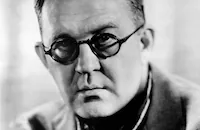
John Ford
Cast

John Wayne

Joanne Dru

John Agar

Ben Johnson

Harry Carey Jr.

Victor Mclaglen

Mildred Natwick
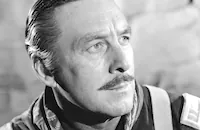
George O'brien
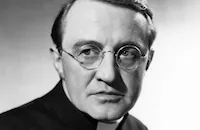
Arthur Shields
Michael Dugan
Chief John Big Tree
Fred Graham
Chief Sky Eagle
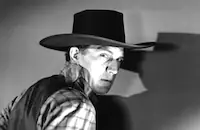
Tom Tyler
Noble Johnson
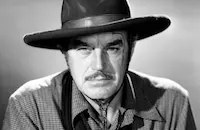
Harry Woods
Cliff Lyons
Mickey Simpson
Frank Mcgrath
Don Summers
Fred Libby
Jack Pennick
Billy Jones
Bill Goettinger
Post Park
Fred Kennedy
Rudy Bowman
Ray Hyke
Lee Bradley
Francis Ford
Crew
C. Bakaleinikoff
James Basevi
Charles Boyle
Jack Caffee
Lucien Cailliet
Robert J. Campbell
Don Cash
Tom Clement
Merian C. Cooper
Lowell Farrell
John Ford
Jack Golconda
Harvey Gould
Richard Hageman
D. R. O. Hatswell
Winton Hoch
Alex Kahle
Natalie Kalmus
Patrick Kelley
Maj. Philip J. Kieffer
Joe Kish
Cliff Lyons
Anna Malin
Michael Meyers
Jack Murray
Frank Nugent
Edward O'fearna
Morgan Padelford
Ann Peck
Clem Portman
Wingate Smith
Laurence Stallings
Meta Sterne
Frank Webster

Photo Collections
Videos
Movie Clip





Trailer
Hosted Intro



Film Details
Technical Specs

Award Wins
Best Cinematography
Articles
She Wore A Yellow Ribbon
By the time of the release of She Wore a Yellow Ribbon (1949), however, Ford was beginning to lose favor with critics. Post-war Hollywood was turning toward stark realism and contemporary themes. The classic popular genres, among them musicals and westerns, were starting to be regarded as old hat and irrelevant to the concerns of the day. But audiences obviously still found something in Ford's work that the critics either missed or dismissed because from the first day of its release, She Wore a Yellow Ribbon was a solid box-office hit, and today it's regarded as one of his finest.
Set in 1876, shortly after Custer's defeat at Little Big Horn, the film tells the story of 43-year cavalry veteran Captain Nathan Brittles (Wayne), who faces an Indian uprising on the eve of his retirement. With this, the second picture in Ford's cavalry trilogy (bookended by 1948's Fort Apache and Rio Grande in 1950), the director further displayed his fascination with the heightened sense of camaraderie among fighting men and the value of tradition and ritual. It also gave Wayne one of his most memorable roles, playing a man a generation older than himself with a more vulnerable side; something the actor had rarely shown before. Years later, Wayne spoke admiringly about the touches Ford added to give dimension to his character, such as the scene where Brittles, accepting a watch from his troops as a retirement gift, comically fumbles with a pair of bifocals to look at the inscription.
But this proved to be a critical disappointment for Wayne, too. Although several reviewers praised his portrayal, the general critical consensus was not in favor of his trying something new and expanding his range. Wayne recalled rather bitterly that he never got the credit he deserved for the picture, so he just went back to "re-acting" for the rest of his career, an assessment that would seem odd to anyone who's ever seen him in Ford's The Searchers (1956).
Reviews aside, audiences were happy to be back in familiar Ford territory, not only in the company of several actors who made up a sort of stock company for the director (including Wayne, Victor McLaglen and Harry Carey Jr.) but in the breathtaking landscape of Monument Valley. By the time he made this movie, Ford considered the location on the Arizona-Utah border his lucky spot and knew every inch of it. To capture it, he hired Winton C. Hoch, one of the pioneers of Technicolor and the foremost color cinematographer in the business. Ford, Hoch and art director Jim Basevi pored over Remington's paintings for the look and feel of the Old West. But although Hoch was meticulous about focus, frame and lighting, he almost didn't get one of the most famous and characteristic shots in the picture, an incident that marked the beginning of his long but tempestuous working relationship with Ford.
At one point, while shooting a line of soldiers on horseback, a desert storm kicked up. Ford thought the angry, dramatic clouds made a good backdrop for the scene, but Hoch insisted there wasn't enough light. Ford demanded the cameras be kept rolling anyway, and Hoch filed a formal complaint with the American Society of Cinematographers saying the shot was unacceptable and that he had been forced to do it. But on Academy Award night the following year, Hoch was the only one of the cast and crew to walk away with an Oscar.
Producer: Merian C. Cooper
Director/Producer: John Ford
Writing Credits: James Warner Bellah, Frank S. Nugent, Laurence Stallings
Cinematographer: Charles P. Boyle, Winton Hoch
Costume Design: Michael Meyers, Ann Peck
Film Editing: Jack Murray
Music: Richard Hageman
Cast: John Wayne (Capt. Nathan Brittles), Joanne Dru (Olivia Dandridge), John Agar (Lt. Flint Cohill), Ben Johnson (Sgt. Tyree), Victor McLaglen (Sgt. Quinncannon), Mildred Natwick (Mrs. Abby Allshard), Harry Carey Jr. (Lieutenant Pennell)
C-104m. Closed captioning. Descriptive video.
by Rob Nixon

She Wore A Yellow Ribbon
TCM Remembers - John Agar
Popular b-movie actor John Agar died April 7th at the age of 81. Agar is probably best known as the actor that married Shirley Temple in 1945 but he also appeared alongside John Wayne in several films. Agar soon became a fixture in such films as Tarantula (1955) and The Mole People (1956) and was a cult favorite ever since, something he took in good spirits and seemed to enjoy. In 1972, for instance, the fan magazine Famous Monsters of Filmland mistakenly ran his obituary, a piece that Agar would later happily autograph.
Agar was born January 31, 1921 in Chicago. He had been a sergeant in the Army Air Corps working as a physical trainer when he was hired in 1945 to escort 16-year-old Shirley Temple to a Hollywood party. Agar apparently knew Temple earlier since his sister was a classmate of Temple's. Despite the objections of Temple's mother the two became a couple and were married shortly after. Temple's producer David Selznick asked Agar if he wanted to act but he reportedly replied that one actor in the family was enough. Nevertheless, Selznick paid for acting lessons and signed Agar to a contract.
Agar's first film was the John Ford-directed Fort Apache (1948) also starring Temple. Agar and Temple also both appeared in Adventure in Baltimore (1949) and had a daughter in 1948 but were divorced the following year. Agar married again in 1951 which lasted until his wife's death in 2000. Agar worked in a string of Westerns and war films such as Sands of Iwo Jima (1949), Breakthrough (1950) and She Wore a Yellow Ribbon (1949). Later when pressed for money he began making the films that would establish his reputation beyond the gossip columns: Revenge of the Creature (1955), The Brain from Planet Arous (1957), Invisible Invaders (1959) and the mind-boggling Zontar, the Thing from Venus (1966). The roles became progressively smaller so Agar sold insurance and real estate on the side. When he appeared in the 1988 film Miracle Mile his dialogue supposedly included obscenities which Agar had always refused to use. He showed the director a way to do the scene without that language and that's how it was filmed.
By Lang Thompson
DUDLEY MOORE, 1935-2002
Award-winning actor, comedian and musician Dudley Moore died on March 27th at the age of 66. Moore first gained notice in his native England for ground-breaking stage and TV comedy before later building a Hollywood career. Like many of his peers, he had an amiable, open appeal that was balanced against a sharply satiric edge. Moore could play the confused innocent as well as the crafty schemer and tended to command attention wherever he appeared. Among his four marriages were two actresses: Tuesday Weld and Suzy Kendall.
Moore was born April 19, 1935 in London. As a child, he had a club foot later corrected by years of surgery that often left him recuperating in the hospital alongside critically wounded soldiers. Moore attended Oxford where he earned a degree in musical composition and met future collaborators Peter Cook, Jonathan Miller and Alan Bennett. The four formed the landmark comedy ensemble Beyond the Fringe. Though often merely labelled as a precursor to Monty Python's Flying Circus, Beyond the Fringe was instrumental in the marriage of the piercing, highly educated sense of humor cultivated by Oxbridge graduates to the modern mass media. In this case it was the revue stage and television where Beyond the Fringe first assaulted the astonished minds of Britons. Moore supplied the music and such songs as "The Sadder and Wiser Beaver," "Man Bites God" and "One Leg Too Few." (You can pick up a CD set with much of the stage show. Unfortunately for future historians the BBC commonly erased tapes at this period - why? - so many of the TV episodes are apparently gone forever.)
Moore's first feature film was the 1966 farce The Wrong Box (a Robert Louis Stevenson adaptation) but it was his collaboration with Peter Cook on Bedazzled (1967) that's endured. Unlike its tepid 2000 remake, the original Bedazzled is a wolverine-tough satire of mid-60s culture that hasn't aged a bit: viewers are still as likely to be appalled and entertained at the same time. Moore not only co-wrote the story with Cook but composed the score. Moore appeared in a few more films until starring in 10 (1979). Written and directed by Blake Edwards, this amiable comedy featured Moore (a last-minute replacement for George Segal) caught in a middle-aged crisis and proved popular with both audiences and critics. Moore's career took another turn when his role as a wealthy alcoholic who falls for the proverbial shop girl in Arthur (1981) snagged him an Oscar nomination as Best Actor and a Golden Globe win.
However Moore was never able to build on these successes. He starred in a passable remake of Preston Sturges' Unfaithfully Yours (1984), did another Blake Edwards romantic comedy of moderate interest called Micki + Maude (1984, also a Golden Globe winner for Moore), a misfired sequel to Arthur in 1988 and a few other little-seen films. The highlight of this period must certainly be the 1991 series Orchestra where Moore spars with the wonderfully crusty conductor Georg Solti and leads an orchestra of students in what's certainly some of the most delightful television ever made.
By Lang Thompson
TCM Remembers - John Agar
Quotes
Never apologize, Mister. It's a sign of weakness.- Captain Nathan Brittles
That ain't my department, sir.- Sgt. Tyree
Join me in a chaw of tobacco, Sergeant?- Captain Nathan Brittles
No, sir. I don't chew tobacco and I don't play cards.- Sgt. Tyree
Chewing tobacco is a nasty habit. Been known to turn a man's stomach.- Captain Nathan Brittles
Well, how did "Marching Through Georgia" take the news that he'd be escorting Old Iron Pants to the stage?- Abby Allshard
Under protest, Abby. It's alway's my pleasure to escort Old Iron Pants... Abby, that is the dad blastedest outfit I've ever seen. Quincannon's old britches.- Captain Nathan Brittles
You got a breath on you like a mince pie.- Captain Nathan Brittles
Oh, no sir. I took "the pledge" after Chapultepec.- Top Sergeant Quincannon
And 2nd Bull Run. And Appomattox. and St. Patrick's Day.- Captain Nathan Brittles
Trivia
When Sgt. Quincannon is addressing the troops and warning them to "watch them words", he asks who owns a dog, without receiving an answer, and concludes, "Nice dog! Irish setter!" The scene was improvised on the spot by Director Ford. The dog was an unnamed Navaho pet that had fallen asleep during the set up. Multiple takes were required because McLaglen kept blowing the line, calling the dog a "cocker spaniel".
Notes
An offscreen narrator provides commentary intermittently throughout the film. In the onscreen credits, technical advisor Maj. Philip J. Kieffer's credit reads as "Major Philip Kieffer U.S.A., Retd." In addition to "She Wore a Yellow Ribbon," the traditional song "The Girl I Left Behind Me" is also heard in part in the film. She Wore a Yellow Ribbon was the second film in John Ford's "cavalry" trilogy, and the only one to be shot in color. Hollywood Reporter news items add the following information about the production: In August 1948, Argosy Pictures was negotiating for Charles Bickford to play the film's lead. As with Ford's previous cavalry film, Fort Apache, most of the picture was shot in Monument Valley in southern Utah and northeastern Arizona. Harold von Schmidt, an illustrator for The Saturday Evening Post, was hired to do "special advertising" illustrations for the picture. Modern sources add the following information about the film: James Warner Bellah worked on the original screen adaptation of his short stories. After Bellah, Laurence Stallings was brought in to improve the script's pacing, structure and dialogue. In addition to expanding certain moments from the short stories, Stallings developed the romantic sub-plot between "Olivia" and the two lieutenants. Frank Nugent was then hired to polish the script.
The film was budgeted at $1,851,290, $40,000 less than Fort Apache, and because of Ford's familiarity with the Monument Valley area, it was completed after only thirty-one days of shooting and was brought in almost $500,000 under budget. In a modern interview, Ford notes that he and photographer Winton Hoch attempted to duplicate the style of Frederic Remington's western paintings in their screen images. During production, Hoch filed a formal protest with the American Society of Cinematographers, complaining that a scene that Ford ordered him to shoot during a desert storm was not acceptable to him. Hoch won an Academy Award for Best Cinematography (Color) for his work on this film, and despite his differences with Ford during the production, went on to shoot other notable pictures for him, including The Quiet Man and The Searchers. Modern sources credit Barbara Ford (Ford's daughter) as assistant editor and add Paul Fix and Dan White to the cast. For more information on Ford's cavalry trilogy, for Fort Apache. John Wayne reprised his role in a March 12, 1951 Lux Radio Theatre broadcast, co-starring Mel Ferrer.

Miscellaneous Notes
Released in United States Fall October 22, 1949
Released in United States November 23, 1988
Released in United States on Video May 31, 1989
Released in United States September 1988
Re-released in United States on Video May 9, 1995
Shown at London Film Festival (Retrospective) November 23, 1988.
Shown at Toronto Festival of Festivals September 8-17, 1988.
Re-released in United States on Video May 9, 1995
Released in United States on Video May 31, 1989
Released in United States September 1988 (Shown at Toronto Festival of Festivals September 8-17, 1988.)
Released in United States Fall October 22, 1949
Released in United States November 23, 1988 (Shown at London Film Festival (Retrospective) November 23, 1988.)














